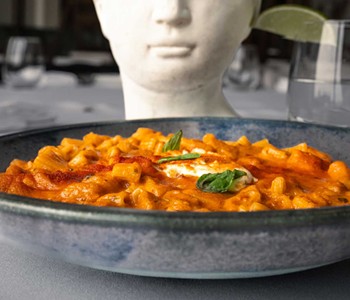If the chef at Tiliani recommends a restaurant, take heed. I am a fan of Hisham Diab, who helms the stellar new spot in Dearborn, and he’s the one who told me to try Detroit’s Kalahari African Cuisine.
You should take Kalahari’s printed menu with a grain of salt (not that the food needs salting) — what’s actually available varies. Both times I dropped in, I was disappointed to find Kalahari out of maffe yap, a lamb and peanut butter stew, as that is Diab’s go-to dish. The owner says you can call ahead to find whether it will be offered on a given day (but go early). Otherwise, you may be greeted with “I have lamb, chicken, and fish.” Turkey wings, fufu, jerk chicken, stuffed roast lamb, fataya (fish patties), and steak with white sauce (!) are also listed. I wanted to try the ginger drink and the bissap drink, from hibiscus, but no go. Green tea in a footed glass was offered for free when the meal was over.
I am always happy to order lamb, though, and enjoyed a big pile of crusty kabobs, many with the fat on, served with jollof rice. This was under the heading of “Dibi (Lamb),” whose description reads “kabob chicken, beef, or shrimps.” Like I said, trust not the printed word. On one occasion they substituted spring rolls for another dish and then undercharged us both for that item and for another one.
Jollof rice is one of those dishes with infinite variations, country by country and cook by cook, involving tomatoes, onions, spices and whatever vegetables or proteins the maker desires that day, all cooked in one pot. In the mid-2010s West Africa saw friendly “jollof wars” over whose was best. Washington, D.C. holds an annual jollof contest that’s judged blind, to head off accusations of native-son favoritism.
Kalahari’s chestnut-brown version appears simple, without visible additives, and it has a nutty flavor. Quantities were bountiful.
We also enjoyed a crisp whole grilled red snapper, well done, easy to detach from its skeleton and worth the effort, served with spiced grilled onions.
If you order the whole chicken, it will be chopped into square pieces, except for the drumsticks, warmly spiced and grilled a dark red brown. It’s not as tender or juicy as American fried chicken but worthy for the crunch and the spicing.
Perhaps even more than these hefty main dishes, I liked Kalahari’s spring rolls, called “nems,” with nuoc mam sauce. The wrapper is a dream of lightness and crunchiness, delicately browned, stuffed with cilantro, shrimp, vermicelli, mushrooms, and onions. And they’re just three for $7. Sticking with the roll theme, chicken shawarma comes in a lightly crisped, thin pita, stuffed with well-spiced chicken chunks. Both of these would be good for takeout or for when you don’t want a heavy meal. Or just because they’re so good.
Fried plantains varied from visit to visit, one night crisper and less sweet, but always served in a big delicious heap.
Kalahari is very informal. Paper towels serve as napkins, though plates and silverware are real, not plastic (plastic forks being a regrettable growing trend). Walls are painted orange, tablecloths are bright, place mats are shiny gold. A mural of charismatic African fauna is the main decoration.






